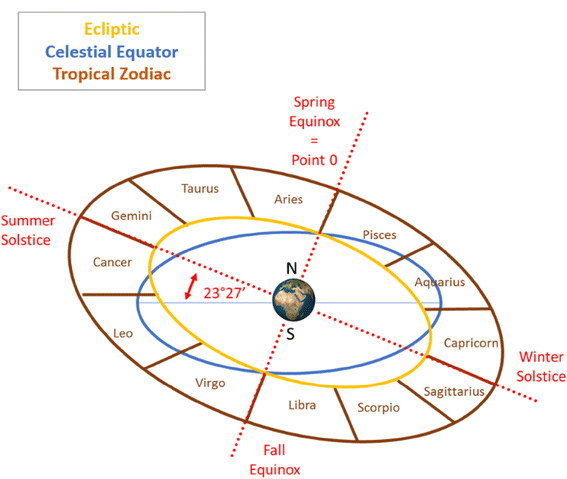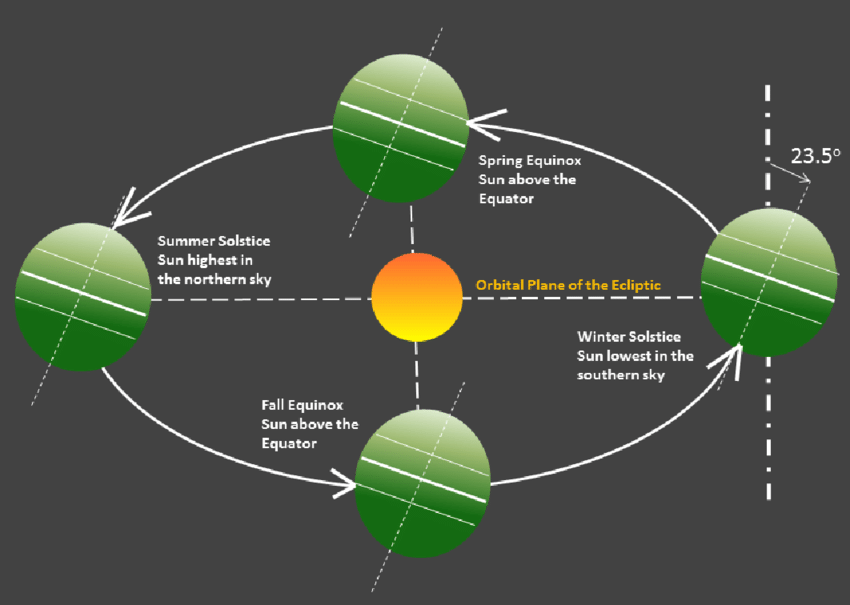
One of the fundamental premises of both astrology and cosmobiology is the need to measure the location of planets in our solar system at any given moment, into the past, currently, and into the future.
There are several ways of doing this, but the most convenient way is to use the tropical zodiac.
An ephemeris, which is a book of tables that has pre-calculated positions of the Sun, Moon and planets given for either midday or midnight Universal Time is used for this. Prior to the widespread use of computers, a printed ephemeris, which usually covered a century, was the only way to calculate these positions. A correction calculation was then required depending on the location on Earth and the time of interest for a chart. Computers nowadays calculate precise positions for any given location on Earth in local time.
The ephemeris gives the position of the Sun, Moon and planets in the form of a degree and minute of an astrological sign. For instance 10° Aries 29′. Each sign contains 30 degrees and 12 signs make up the whole 360° of the tropical zodiac.
Unlike astrology though, cosmobiology places no emphasis on the signs of the zodiac having any influence on personality. They are simply used to find the location of these celestial bodies.
The tropical zodiac should be considered as a tool to only measure the positions of the planets. It is linked to our seasons and to our Earth’s orbit of the Sun. The signs however are used only as a convenient way to divide up the 360 degrees that makes up the orbital path of our Earth, as well as the orbits of the other celestial bodies.
Over the years scientists have taken great pleasure in attacking astrology by highlighting that the tropical zodiac as used by astrologers bears no resemblance to the alignment of the actual constellations. They say that if you are born with Sun in Capricorn for instance, the actual constellation the Sun may have been transiting at the time may have been Sagittarius and therefore that discredits the theory that astrological signs affect personality. They are correct in that the actual constellation may differ from the one referred to in tropical zodiac, but also misinformed about the actual use of the signs of the zodiac.
You can make up your own zodiac signs if you wish. You could use breeds of dogs for instance. As long as you have a way to have a grouping of 3 and a grouping of 4, there is nothing stopping you doing that. The reason for that will become clear shortly.
The tropical zodiac begins at 0° Aries 00′ on the 20th or 21st March. In the northern hemisphere this is known as the vernal equinox. We tend to call it the Autumn equinox in the southern hemisphere. This equinox can be calculated exactly to the minute thanks to modern technology. It is the moment when the Sun crosses the celestial equator and the length of day and night is of approximately the same time in both the northern and southern hemispheres.

Earth does not orbit the Sun on a flat plane, meaning our equator being parallel to the plane of our orbit. Instead, the Earth’s axis is tilted at 23° 27′ to the perpendicular of our orbital plane. It is this tilt that causes our seasons to occur.
Figure 2 provides a visual depiction of how the Earth orients towards the Sun throughout the year causing the four seasons that we know of, to occur.
This basic astronomy overview is necessary to help understand how the tropical zodiac is used, because it is explicitly linked to the natural cycle.
In the tropical zodiac the two equinoxes and two solstices are known as cardinal points. The entire orbit of Earth is about 365.25 days. Time is corrected every four years with an extra day added to the calendar being February 29. This is known as a leap year and is the reason we have it every four years. The cardinal points can be calculated precisely to the minute and this heralds a new quarter of the year.
The four cardinal points are 0° Aries 00′, 0° Cancer 00′, 0° Libra 00′ and 0° Capricorn 00′.
The periods of time heralded by the cardinal points and dividing the year into quarters are further divided into thirds. This gives us 12 signs and the 12 months of our calendar year follow roughly along with them, however beginning on different days approximately 21 days apart.
The first sign in a quarter is known as a cardinal sign. The 30° of this sign equates to about 30 days of orbital travel by the Earth. When the Earth completes that 30 degrees of travel it moves into the second zodiac sign of the triad.
The signs following the cardinal signs are known as fixed signs. The fixed signs are Taurus, Leo, Scorpio and Aquarius. Likewise, these contain 30° and represent about 30 days of orbital travel of the Earth.
When travel through a fixed sign has been completed, the final sign of the triad is entered. These are known as a mutable sign. The mutable signs are Gemini, Virgo, Sagittarius and Pisces.
As previously mentioned it really doesn’t matter what you call these divisions as long as you have a way to divide them up in this manner. Because an ephemeris presents planetary positions using these conventions it remains convenient to continue using this methodology, and it aligns with the natural cycle of Earth’s orbit from which all our measurements are derived in any case.
In the next article I will be presenting other ways that positions of celestial bodies are often referenced.
